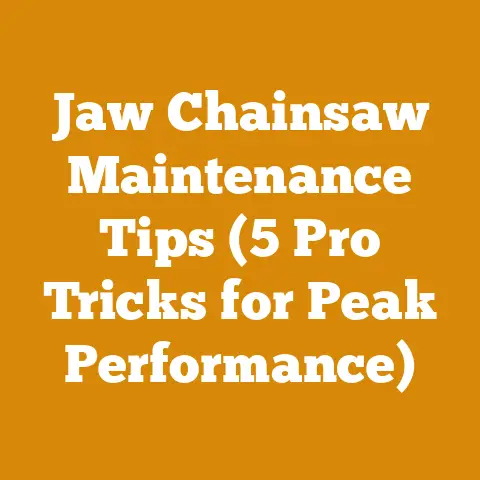Removing a Link from a Chainsaw Chain (3 Pro Tips for Pitch Accuracy)
I’m excited to dive into a topic that might seem small but can make a huge difference in your chainsaw’s performance: removing a link from a chainsaw chain.
It’s not always about adding links; sometimes, taking one out is the key to a perfectly tensioned and efficiently cutting chain.
And trust me, I’ve learned this lesson the hard way, more times than I care to admit!
My “Chain” of Blunders
I still remember my early days, wrestling with a brand-new chain that was just a tad too long for my trusty old saw.
I’d slap it on, crank the tension adjuster, and end up with a chain that either drooped like a sad willow or was tighter than a drum.
It was frustrating and, frankly, a little embarrassing.
After ruining a few chains and spending way too much time fiddling, I finally learned the art of link removal.
Now, I’m here to share those hard-earned lessons with you.
Let’s make sure you get it right the first time, saving you time, money, and a whole lot of frustration.
Understanding Chainsaw Chain Pitch and Gauge
Before we get into the nitty-gritty of removing a link, let’s quickly review some fundamental concepts: pitch and gauge.
These are crucial for ensuring your chain is compatible with your chainsaw and that your adjustments are accurate.
Pitch Explained
Pitch is the distance between any three consecutive rivets on the chain, divided by two.
It’s usually measured in inches.
Common chainsaw pitches are 0.325″, 3/8″ (0.375″), and 0.404″.
Why does this matter?
Because the pitch of your chain must match the pitch of your chainsaw’s drive sprocket and guide bar.
If they don’t match, the chain won’t engage properly, leading to poor cutting performance and potential damage to your equipment.
Gauge Defined
Gauge refers to the thickness of the drive links – the part of the chain that sits in the guide bar groove.
It’s also measured in inches or millimeters.
Common gauges include 0.043″, 0.050″, 0.058″, and 0.063″.
Again, the gauge of your chain must match the width of the guide bar groove.
A chain with the wrong gauge will either be too loose, causing it to derail, or too tight, leading to excessive wear and tear on the bar and chain.
Why Pitch and Gauge Matter When Removing a Link
Now, you might be wondering, “What does all this have to do with removing a link?” Well, when you remove a link, you’re essentially altering the overall length of the chain.
If you’re not careful and don’t account for the pitch and gauge, you could end up with a chain that’s either too short or incompatible with your saw.
This is why understanding these measurements is critical before you even think about reaching for your chain breaker.
Takeaway
Always double-check the pitch and gauge of your chain, guide bar, and drive sprocket before making any adjustments.
This simple step can save you a lot of headaches down the road.
When and Why You Might Need to Remove a Link
Okay, so when exactly would you need to remove a link from your chainsaw chain?
It’s not as common as adding links, but there are a few scenarios where it can be a lifesaver.
Chain Stretching and Adjustment Limits
Chains stretch over time.
It’s a natural part of their life cycle as they wear and the metal fatigues.
Your chainsaw has a tension adjustment mechanism to compensate for this stretching.
However, there comes a point where the chain stretches beyond the adjustment range.
In this case, the chain will be too loose, even with the tensioner fully extended.
Removing a link can bring the chain back within the adjustable range, allowing you to continue using it safely and effectively.
Chain Damage Requiring Repair
Sometimes, a chain can get damaged in a specific area.
Maybe you hit a rock, or a tooth breaks off.
If the damage is localized, you might be able to repair the chain by removing the damaged section.
This is often more cost-effective than replacing the entire chain, especially if the rest of the chain is in good condition.
Adjusting Chain Length for Different Guide Bars
I’ve run into this situation more than once.
Let’s say you have multiple guide bars for your chainsaw, maybe a shorter one for limbing and a longer one for felling larger trees.
If you switch between bars, you might find that your chain is slightly too long for the shorter bar.
Instead of buying a new chain, you can remove a link to make it the perfect length for the smaller bar.
Fine-Tuning New Chains
Even brand-new chains sometimes need a little tweaking.
Manufacturing tolerances aren’t always perfect, and you might find that a new chain is just a hair too long for your saw.
Removing a single link can provide that perfect fit, ensuring optimal cutting performance from the get-go.
Avoiding Common Mistakes
One mistake I see people make is trying to remove multiple links at once.
This is almost always a bad idea.
It’s better to remove one link at a time, test the fit, and then remove another if necessary.
Remember, you can always take more off, but you can’t put it back on!
Takeaway
Removing a link is a useful skill for maintaining your chainsaw chains.
It can help you extend the life of your chains, save money on replacements, and optimize your saw’s performance.
Tools You’ll Need for the Job
Before you start tearing into your chainsaw chain, you’ll need the right tools.
Having the proper equipment will make the job much easier, safer, and more precise.
Essential Tools
- Chain Breaker/Rivet Spinner: This is the most important tool for removing and installing chain links.
A chain breaker uses a pin to push the rivet out of the link, allowing you to separate the chain.
Some models also have a rivet spinner for reassembling the chain.
I recommend investing in a good quality chain breaker, as the cheap ones can be flimsy and prone to breaking. - Hammer and Punch (Alternative Method): If you don’t have a chain breaker, you can use a hammer and punch to drive the rivets out.
However, this method is less precise and can be more difficult, especially for beginners. - Needle-Nose Pliers: These are useful for manipulating the small chain components and holding the chain in place while you work.
- Work Gloves: Always wear gloves when working with chainsaw chains.
They’re sharp, greasy, and can easily cut your hands. - Safety Glasses: Protect your eyes from flying debris when hammering or using the chain breaker.
Nice-to-Have Tools
- Chain Vise: A chain vise holds the chain securely in place, making it easier to work on.
It’s not essential, but it can be a helpful addition to your toolkit. - Magnifying Glass: If you have trouble seeing the small rivets and chain components, a magnifying glass can be a lifesaver.
- Rivet Anvil: Some chain breakers come with a rivet anvil, which provides a stable surface for spinning the rivets when reassembling the chain.
Tool Recommendations
Over the years, I’ve tried a variety of chain breakers, and I’ve found that the Oregon 35850 Chain Breaker is a solid choice for most users.
It’s durable, easy to use, and can handle a wide range of chain sizes.
For a more budget-friendly option, the Farmertec Chain Breaker is a decent alternative, but it may not be as durable as the Oregon model.
Tool Maintenance
Like any tool, your chain breaker needs to be properly maintained to ensure it functions correctly.
Keep it clean and lubricated, and replace the punch pin when it becomes worn or damaged.
A well-maintained chain breaker will last longer and make your chain adjustments much easier.
Takeaway
Having the right tools is essential for safely and effectively removing a link from your chainsaw chain.
Invest in a good quality chain breaker and keep it properly maintained.
Step-by-Step Guide to Removing a Link
Alright, let’s get down to the actual process of removing a link from your chainsaw chain.
I’m going to walk you through each step, providing tips and tricks along the way.
Step 1: Prepare Your Work Area
Find a clean, well-lit workspace.
This will make it easier to see the small chain components and prevent you from losing any parts.
Lay down a piece of cardboard or a shop towel to protect your work surface and catch any oil or debris.
Step 2: Identify the Link to Remove
Carefully inspect the chain and identify the link you want to remove.
If you’re removing a damaged link, make sure you remove the entire damaged section.
If you’re simply shortening the chain, choose a link that’s easy to access and won’t interfere with the flow of the chain.
Step 3: Position the Chain in the Chain Breaker
Place the chain in the chain breaker, aligning the rivet you want to remove with the punch pin.
Make sure the chain is seated properly in the breaker and that the punch pin is centered on the rivet.
Step 4: Drive Out the Rivet
Turn the handle on the chain breaker to drive the punch pin through the rivet.
Apply steady pressure and avoid forcing it.
If the rivet is particularly stubborn, you can try tapping the chain breaker with a hammer to help loosen it.
Continue turning the handle until the rivet is completely pushed out of the link.
Step 5: Separate the Chain
Once the rivet is removed, you should be able to easily separate the chain at that point.
If the chain is still stuck, double-check that the rivet is completely out and that there are no other obstructions.
Step 6: Reassemble the Chain (If Necessary)
If you’re removing a damaged section of the chain, you’ll need to reassemble the chain by connecting the two loose ends.
To do this, insert a new connecting link into the chain, aligning the holes with the rivets.
Use the chain breaker to spin the rivets and secure the connecting link in place.
Step 7: Inspect Your Work
Carefully inspect your work to ensure that the chain is properly reassembled and that all the rivets are securely in place.
Check for any loose links or signs of damage.
Step 8: Test the Chain
Before you put the chain back on your chainsaw, test it by flexing it and checking for any binding or stiffness.
The chain should move freely and smoothly.
Common Mistakes to Avoid
- Forcing the Rivet: If the rivet is stuck, don’t force it.
This can damage the chain breaker or the chain.
Try tapping the breaker with a hammer or using a penetrating oil to loosen the rivet. - Losing Small Parts: The rivets and connecting links are small and easy to lose.
Work in a clean, well-lit area and keep a close eye on all the parts. - Over-Tightening the Rivets: When reassembling the chain, don’t over-tighten the rivets.
This can cause the chain to bind and reduce its cutting performance.
Takeaway
Removing a link from a chainsaw chain is a straightforward process, but it requires attention to detail and the right tools.
Follow these steps carefully and avoid common mistakes to ensure a successful outcome.
Pro Tip #1: Measuring for Accuracy
Accuracy is key when removing a link from a chainsaw chain.
You don’t want to end up with a chain that’s either too short or too long.
Here’s how to measure accurately:
Measuring the Existing Chain
Before you remove any links, measure the existing chain on your chainsaw.
Use a flexible measuring tape to measure the circumference of the chain while it’s installed on the guide bar.
Note this measurement.
Determining the Ideal Length
Consult your chainsaw’s manual or the guide bar manufacturer’s specifications to determine the ideal chain length for your saw and bar combination.
This information is usually expressed in terms of the number of drive links.
Calculating the Difference
Subtract the ideal chain length (in drive links) from the existing chain length (in drive links).
This will tell you how many links you need to remove.
Accounting for Chain Stretch
Keep in mind that chains stretch over time.
If your chain is already stretched, you might want to remove one less link than calculated to compensate for future stretching.
Using a Chain Gauge
A chain gauge is a handy tool for accurately measuring chain length and pitch.
It can help you quickly determine the number of drive links and ensure that your chain is the correct size for your saw.
Example Scenario
Let’s say you have a chain with 72 drive links, and your chainsaw’s manual specifies that the ideal chain length is 70 drive links.
In this case, you would need to remove one link to achieve the correct chain length.
However, if your chain is already stretched, you might want to remove only one link to allow for future stretching.
Takeaway
Accurate measurement is essential for achieving the perfect chain length.
Use a flexible measuring tape, consult your chainsaw’s manual, and consider using a chain gauge to ensure that your chain is the correct size for your saw.
Pro Tip #2: Tensioning After Link Removal
Once you’ve removed a link from your chainsaw chain, proper tensioning is crucial for safe and effective operation.
Here’s how to tension your chain correctly:
Loosening the Bar Nuts
Start by loosening the bar nuts on your chainsaw.
These nuts hold the guide bar in place and allow you to adjust the chain tension.
Loosen them just enough so that you can move the guide bar with your hand.
Adjusting the Tensioning Screw
Locate the tensioning screw on your chainsaw.
This screw is usually located on the side of the saw, near the guide bar.
Turn the tensioning screw clockwise to tighten the chain and counterclockwise to loosen it.
Achieving the Correct Tension
The correct chain tension is when the chain can be pulled away from the guide bar by about 1/8″ to 1/4″ (3-6 mm) at the midpoint of the bar.
When you release the chain, it should snap back into place against the bar.
Checking for Sag
After tensioning the chain, check for any sag on the underside of the guide bar.
If the chain is sagging, it’s too loose and needs to be tightened further.
Tightening the Bar Nuts
Once you’ve achieved the correct chain tension, tighten the bar nuts securely.
Make sure the guide bar is properly seated against the saw body before tightening the nuts.
Rechecking the Tension
After tightening the bar nuts, recheck the chain tension to ensure that it hasn’t changed.
If the tension has changed, loosen the bar nuts and readjust the tensioning screw as needed.
Avoiding Over-Tensioning
Over-tensioning the chain can cause excessive wear and tear on the chain, guide bar, and drive sprocket.
It can also make the saw more difficult to start and operate.
Always err on the side of slightly looser tension rather than over-tightening.
Takeaway
Proper chain tension is essential for safe and effective chainsaw operation.
Follow these steps to tension your chain correctly and avoid common mistakes.
Pro Tip #3: Sharpening After Adjustment
After removing a link and re-tensioning your chainsaw chain, it’s a good idea to give it a quick sharpening.
Here’s why and how:
Why Sharpen After Adjustment?
Removing a link can slightly alter the geometry of the chain, affecting the cutting angle of the teeth.
Additionally, the process of removing and reassembling the chain can sometimes dull the teeth slightly.
Sharpening after adjustment ensures that your chain is cutting at its optimal performance.
Tools for Sharpening
- Round File and File Guide: This is the most common method for sharpening chainsaw chains.
A round file is used to sharpen the cutting edges of the teeth, and a file guide helps maintain the correct angle and depth. - Flat File and Depth Gauge Tool: A flat file is used to adjust the depth gauges, which control the amount of wood each tooth can cut.
A depth gauge tool helps ensure that the depth gauges are set to the correct height. - Chainsaw Sharpener (Electric or Manual): These sharpeners provide a more precise and consistent sharpening than hand filing.
They’re a good investment for those who sharpen their chains frequently.
Sharpening Procedure
- Secure the Chain: Secure the chain in a vise or on the guide bar to prevent it from moving while you sharpen.
- File the Cutting Edges: Use the round file and file guide to sharpen the cutting edges of each tooth.
Maintain the correct angle and depth, and file each tooth evenly. - Adjust the Depth Gauges: Use the flat file and depth gauge tool to adjust the height of the depth gauges.
The depth gauges should be set slightly lower than the cutting edges. - Check Your Work: After sharpening, inspect the chain to ensure that all the teeth are evenly sharpened and that the depth gauges are set correctly.
Maintaining Sharpness
Sharpen your chainsaw chain regularly to maintain its cutting performance.
A sharp chain will cut faster, more efficiently, and with less effort.
It will also reduce the risk of kickback and other accidents.
Knowing When to Sharpen
A dull chain will produce fine sawdust instead of chips, require more force to cut, and may cause the saw to vibrate excessively.
If you notice any of these signs, it’s time to sharpen your chain.
Takeaway
Sharpening after removing a link ensures that your chain is cutting at its optimal performance.
Sharpen your chain regularly and maintain its sharpness to prolong its life and improve your cutting efficiency.
Safety First: Chain and Chainsaw Handling
No discussion about chainsaw chains is complete without a strong emphasis on safety.
Chainsaws are powerful tools, and mishandling them can lead to serious injuries.
Personal Protective Equipment (PPE)
Always wear appropriate PPE when operating a chainsaw. This includes:
- Safety Glasses or Face Shield: Protect your eyes from flying debris.
- Hearing Protection: Chainsaws are loud and can cause hearing damage over time.
- Gloves: Protect your hands from cuts and abrasions.
- Chainsaw Chaps or Pants: These provide protection to your legs in case of accidental contact with the chain.
- Steel-Toed Boots: Protect your feet from falling logs and other hazards.
- Hard Hat: Protect your head from falling branches and other overhead hazards.
Safe Chainsaw Operation
- Read the Manual: Familiarize yourself with your chainsaw’s operating manual before using it.
- Inspect the Saw: Before each use, inspect the saw for any damage or loose parts.
- Start the Saw Safely: Start the saw on the ground, with the chain brake engaged.
- Maintain a Firm Grip: Hold the saw firmly with both hands, keeping your thumbs wrapped around the handles.
- Keep a Safe Distance: Maintain a safe distance from other people when operating the saw.
- Avoid Cutting Overhead: Avoid cutting overhead whenever possible.
- Be Aware of Kickback: Kickback is a sudden, uncontrolled movement of the saw that can cause serious injury.
Be aware of the risk of kickback and take steps to prevent it. - Use the Chain Brake: Engage the chain brake whenever you’re not actively cutting.
- Never Cut Above Shoulder Height: This can lead to loss of control and increased risk of injury.
- Take Breaks: Chainsawing can be physically demanding. Take frequent breaks to avoid fatigue.
Chain Maintenance Safety
- Wear Gloves: Always wear gloves when handling chainsaw chains.
- Use the Right Tools: Use the correct tools for removing and installing chain links.
- Be Careful with Sharp Edges: Chainsaw chains are sharp.
Be careful when handling them to avoid cuts. - Dispose of Chains Properly: Dispose of old or damaged chains properly to prevent injuries.
First Aid
- Know Basic First Aid: Be familiar with basic first aid procedures for treating cuts and other injuries.
- Keep a First Aid Kit Handy: Keep a well-stocked first aid kit on hand when operating a chainsaw.
- Seek Medical Attention: Seek medical attention for any serious injuries.
Takeaway
Safety should always be your top priority when working with chainsaws and chainsaw chains.
Wear appropriate PPE, follow safe operating procedures, and be aware of the risks involved.
Troubleshooting Common Chain Problems
Even with the best care and maintenance, chainsaw chains can sometimes develop problems.
Here are some common issues and how to troubleshoot them:
Chain Won’t Stay on the Bar
- Cause: Chain is too loose, guide bar is worn, drive sprocket is worn, or chain is the wrong size.
- Solution: Tighten the chain, replace the guide bar or drive sprocket, or use the correct size chain.
Chain Cuts Unevenly
- Cause: Chain is dull, teeth are unevenly sharpened, or guide bar is damaged.
- Solution: Sharpen the chain, sharpen the teeth evenly, or replace the guide bar.
Chain Binds or Jams
- Cause: Chain is too tight, chain is damaged, or the cut is pinching the chain.
- Solution: Loosen the chain, repair or replace the chain, or use wedges to prevent the cut from pinching.
Chain Smokes or Overheats
- Cause: Chain is too tight, chain is not properly lubricated, or the wood is too hard.
- Solution: Loosen the chain, lubricate the chain properly, or use a different chain for harder wood.
Chain Breaks Frequently
- Cause: Chain is worn, chain is over-tensioned, or the saw is being used improperly.
- Solution: Replace the chain, adjust the tension properly, or use the saw correctly.
Chain Kicks Back
- Cause: Cutting with the upper quadrant of the guide bar, pinching the chain, or hitting a knot or obstruction.
- Solution: Avoid cutting with the upper quadrant of the guide bar, use wedges to prevent pinching, and be aware of knots and obstructions.
Takeaway
Troubleshooting chain problems can save you time and money.
By identifying the cause of the problem and implementing the appropriate solution, you can keep your chainsaw running smoothly and efficiently.
The Importance of Chain Maintenance
Remember, proper chain maintenance is essential for safe and efficient chainsaw operation.
By keeping your chains properly tensioned, sharpened, and lubricated, you can extend their life, improve your cutting performance, and reduce the risk of accidents.
Continuous Learning
Chainsaw operation is a skill that requires continuous learning and practice.
Stay informed about the latest techniques and safety standards, and always be willing to learn from your mistakes.
My Final Thoughts
I’ve spent countless hours in the woods, felling trees, limbing branches, and preparing firewood.
Along the way, I’ve learned a lot about chainsaws and chainsaw chains.
I’ve made my fair share of mistakes, but I’ve also learned from them.
My goal is to share my knowledge and experience with you so that you can avoid making the same mistakes I did.
So, go out there, take care of your chainsaws, and keep those chains spinning safely and efficiently!
And remember, if you ever have any questions or need any advice, don’t hesitate to reach out.
Happy cutting!






